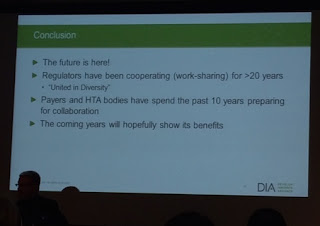Oxford debate: this house believes that over engineered clinical development has inhibited innovation
Panellists: Bettina Ryll (Founder of Melanoma Patient Network Europe) Martin Landray (University of Oxford), Mike Ryan (Medidata Solution), Sam Wadsworth (Dimension Therapeutic) -session chair Jullianne HullMike Ryan
innovation -new ideas
new implies taking risks
regulatory authorities are seeing that as a risk
scientific advices -helpful but time consuming
Martin Landray
To engineer- a methodological approach to integrate elements
there is prudence in engineering in the context of CT
-is quality of clinical design, involving all stakeholders including pts and public
a critical thinking
we should stop to do things that we suppose others are expecting from us
over engineering is not the problem, but forget engineering is the problem
CTs (clinical trials) -have to integrate a critical human element,
each element can be subject of engineering
we live in imperfect world
we do need systems to review errors
''I have heard from Pharma that the new technology are inducing undetermined risks '' so better to not go for new technologies..
but..engineering is the necessity for innovation
Sam Wadsworth
looking to 20 years clinical trials experience
how we engineer clinical trials now
the number of CTs has increased
but the number of new drug approved has decreased
we are asking pts (patients) to take procedures which are not necessary (?!)
Pts and doctors are finding impossible to run CTs
Interactions with specific IT tools within CTs is difficult for doctors/investigators (!)
Bettina Ryll
Not true-the above assertion confounds symptoms with the cause
Innovation in health improves clinical efficacy, cost effectiveness, pharmacovigilance,
Innovation is there to bring timely access to the good drugs to the patients.
Innovation has to be accessible in the right time and for all! ..
Clinical trials with a bad design -from the day they start everybody knows that half of our people would die on inferior comparators: this has to stop and we have to ask ourself for what and for whom we are doing this, what are our real goals.
Innovation has to be sustainable
Regulators comments
The most problems come not for engineering the trials but from designing bad protocols
We have to ask yourself if what we do is meaningful for the research -engineering just for engineering is not the way to go
Statistician view -poor quality of clinical trials in phase II compromises in fact the entire protocol design -should really learn from phase II in order to design properly phase III
''Just think!...'' (Martin Landray)






















